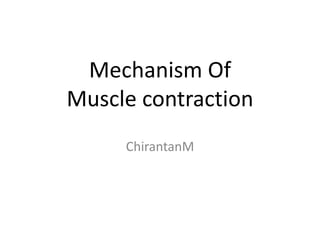
Mechanism and Efficiency of Muscle Contraction Explained
- 1. ChirantanM Mechanism Of Muscle contraction
- 3. Motor Unit Single motorneuron & muscle fibers it innervates Eye muscles – 1:1 muscle/nerve ratio Hamstrings – 300:1 muscle/nerve ratio
- 6. Nicotinic
- 7. deep Invaginatiom of the sarcolemma, allow depolarization of the membrane to quickly penetrate to the interior of the cell enlarged areas of the Sarcoplasmic reticulum surrounding the Transverse Tubules
- 9. Dihydropyridine receptor => DHP Ryanodine receptors => RyRs (calcium-induced calcium release) (physical coupling to the dihydropyridine receptor) (RyRs) Ca2+unbinds from the calcium-binding protein called calsequestrin
- 15. H Band
- 21. Cross-Bridge Formation in Muscle Contraction
- 23. Z line Sarcomere Relaxed
- 27. sarcoplasmic reticulum Ca2+-ATPase actively pumps Ca2+ back into the sarcoplasmic reticulum where Ca2+ rebinds to calsequestrin.
- 31. Sources of ATP for Muscle Contraction Phosphagen energy system (Anaerobic) Glycogen-lactic acid system (Anaerobic) Aerobic system
- 32. CreatineCreatine Phosphate Creatine + ATP Creatine phosphate + ADP Creatine + ATP (Molecule capable of storing ATP energy) (Molecule with stored ATP energy) Creatine phosphate + ADP (Creatine phosphate recycles ADP back into ATP to provide fuel for our muscles) Creatine ~ PO4Creatine + PO4 + Energy
- 33. The three different metabolic systems that we have at our disposal enable different degrees of muscle activation as (different kinds of athletic events require different amounts of energy)
- 34. Sustaining Muscle contractions: ATP Sources/Time Figure 25-2: Speed of ATP production compared with ability to sustain maximal muscle activity
- 35. athletic events requiring a quick "burst" of energy , amount of ATP needed only to be Cattered by Phosphagen System Intermediate athletic activities require extra ATP to fuel the muscles. Now Glucose molecules comes to rescue. The extra ATP that is is provided by glucose break down in the absence of oxygen each glucose molecule is split into two pyruvic acid molecules, and energy is released to form several ATPs, in addition phosphagen system The pyruvic acid partly break down to lactic acid. If the lactic acid accumulates in the muscle, you will have muscle fatigue ( painful cramps) aerobic system => for sports that require an extensive expenditure of energy Lots of ATP provided to your muscles to sustain the muscle power without excessive production of lactic acid. (Oxidation- using glucose/glycogen/fatty acids)
- 36. Utilization of Energy Source for ATP Production Figure 25-3: Use of carbohydrates and fats with increasing exercise
- 40. muscle contracts against a load => performs work. energy is transferred from the muscle to the external load to lift an object to a greater height or energy is transferred to overcome resistance to movement. W = L X D W is the work output, L is the load, and D is the distance of movement against the load. energy required to perform the work is derived from the chemical reactions in the muscle cells during contraction,
- 41. Most of this energy is required to carry out mechanism by which the cross-bridges pull the actin filaments, small amounts are required for pumping calcium ions from the sarcoplasm into the sarcoplasmic reticulum after the contraction is over pumping sodium and potassium ions through the muscle fiber membrane to maintain appropriate ionic environment.
- 42. rate of formation of ATP by the glycolytic process is about 2.5 times as rapid as ATP formation in response to cellular foodstuffs reacting with oxygen glycolytic reactions can occur even in the absence of oxygen, muscle contraction can be sustained for sometimes up to more than a minute, even when oxygen delivery from the blood is not available
- 43. final source of energy is oxidative metabolism. combining oxygen with the end products of glycolysis and with various other cellular foodstuffs to liberate ATP. >95% of all energy used by muscles for sustained, long-term contraction is derived from this source of foodstuffs For extremely long-term maximal muscle activity-over a period of many hours-by far the greatest proportion of energy comes from fats for periods of 2 to 4 hours, as much as one half of the energy can come from stored carbohydrates.
- 44. Efficiency of Muscle Contraction The percentage of the input energy to muscle (the chemical energy in nutrients) that can be converted into work, even under the best conditions, is less than 25 percent, with the remainder becoming heat. The reason for this low efficiency is that about half of the energy in foodstuffs is lost during the formation of ATP, even then, only 40 to 45 percent of the energy in the ATP itself can later be converted into work
- 45. Maximum efficiency can be realized only when the muscle contracts at a moderate velocity. If the muscle contracts slowly or without any movement, small amounts of maintenance heat are released during contraction, even though little or no work is performed, Conversely, if contraction is too rapid, large proportions of the energy are used to overcome viscous friction within the muscle itself, and this, too, reduces the efficiency of contraction. Ordinarily, maximum efficiency is developed when the velocity of contraction is about 30 percent of maximum.
